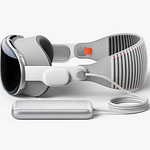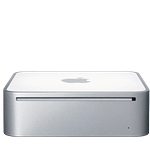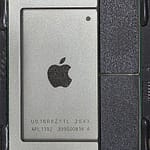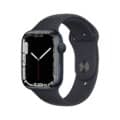- All Apple Devices
- Mac mini
- Apple Mac mini (Late 2006)
Apple Mac mini (Late 2006)

Apple Mac mini (Late 2006)
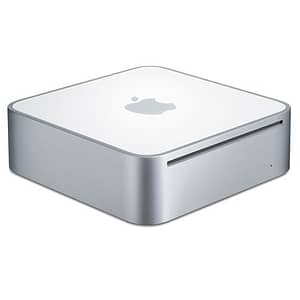
Product Brand: Apple
6
Pros
- Better performance compared to the previous model.
- Dual-core Intel processor.
- Built-in Gigabit Ethernet, Wi-Fi, and Bluetooth.
- Improved graphics performance.
- FireWire 800 and USB 2.0 ports.
- Optical audio input and output.
- S-video and composite video output.
Cons
- Limited upgradability options.
- RAM not user-upgradable.
- Limited graphics performance for heavy tasks.
- No HDMI port.
- Relatively expensive compared to other small form factor PCs.
Apple Mac mini (Late 2006) Overview
The Apple Mac mini (Late 2006) was released in November 2006 and is the successor to the Mac mini (Early 2006). The computer is designed as an affordable entry-level Mac computer that is compact and stylish.
The Mac mini (Late 2006) has a 1.83 GHz or 2.0 GHz Intel Core 2 Duo processor, up to 2GB of DDR2 SDRAM memory, and an integrated Intel GMA 950 graphics processor. It also features a built-in optical drive, up to 120GB hard drive, and includes built-in Bluetooth 2.0 and Wi-Fi.
The Mac mini (Late 2006) is housed in a sleek silver aluminum case that is 6.5 inches square and 2 inches tall. It features a slot-loading optical drive on the front, along with a power button, IR receiver, and a single USB 2.0 port. On the back, there are four additional USB 2.0 ports, a FireWire 400 port, a Gigabit Ethernet port, a DVI video output, and audio in/out ports.
One of the unique features of the Mac mini (Late 2006) is that it includes Apple’s Front Row software, which allows users to easily access and navigate their music, photos, and videos from a distance using the included Apple Remote. The computer also runs on Apple’s Mac OS X 10.4.8 operating system.
Overall, the Mac mini (Late 2006) offers an affordable and compact option for those who want to experience the Mac ecosystem without breaking the bank. Its sleek design and inclusion of Front Row software make it an attractive option for those who want to use their computer as a home entertainment center. However, its lack of a dedicated graphics card and limited upgrade options may not be ideal for those who need more powerful computing capabilities.
Full Technical Specifications
Apple Mac Mini Specifications
| Device Type | Desktop Computer |
| Released | 06 September, 2006 |
| Colors | Silver |
| Case type | Cuboid |
| Height | 2 inches (5.08 cm) |
| Width | 6.5 inches (16.51 cm) |
| Depth | 6.5 inches (16.51 cm) |
| Weight | 2.9 pounds (1.31 kg) |
| Dimensions | 2 x 6.5 x 6.5 inches (51 x 165 x 165 mm) |
| RAM | 512MB or 1GB of 667MHz DDR2 SDRAM, expandable up to 2GB |
| RAM (Type) | DDR2 SDRAM |
| RAM Max | upto 2 GB |
| RAM Slots | 2 Slots |
| Processor Type | 1.66GHz or 1.83GHz Intel Core Duo processor |
| Fabrication process | 65nm fabrication process |
| Processor Architecture | 32-bit |
| Processor Cache |
L1 cache: 32 KB instruction cache and 32 KB data cache per core. L2 cache: 2 MB shared L2 cache for the Core Duo processor and 2 MB shared L2 cache for the Core Solo processor. |
| Processor Speed | 1.6 GHz |
| Processor Details |
1.66GHz or 1.83 Intel Core Duo processor 2MB on-chip L2 cache 667MHz frontside bus |
| Processor/CPU Cores | Dual-core |
| GPU GPU (Graphics Processing Unit) is a single-chip processor designed to rapidly manipulate and alter memory to accelerate the creation of images in a frame buffer intended for output to a display, This includes things such as lighting effects, object transformations, and 3D motion. | Intel GMA950 graphics processor with 64MB or 128MB of shared DDR2 SDRAM |
| GPU Type | Integrated |
| Storage Capacity | 60GB, 80GB, or 120GB Serial ATA hard disk drive |
| Storage Type | Hard Disk drive (HDD) |
| Operating System OS => Every computer system run on a base software called Operating System (OS). Operating System controls all basic operations of the computer (such as smartphone, PDAs, tablet computers and other handheld devices). The Operating System allows the user to install and run third party applications (apps), apps are used to add new functionality to the device. | Mac OS |
| Bluetooth Version | Bluetooth 2.0+EDR (Enhanced Data Rate) |
| Wi-Fi Wi-Fi is a popular wireless networking technology using radio waves to provide high-speed network connections that allows devices to communicate without cords or cables, Wi-Fi is increasingly becoming the preferred mode of internet connectivity all over the world. |
Built-in AirPort Extreme Wi-Fi wireless networking (based on IEEE 802.11g specification) |
| Ports |
Four USB 2.0 ports One FireWire 400 port One FireWire 800 port One DVI output One Gigabit Ethernet port One audio line-in/optical digital audio input, and one headphone/optical digital audio output port |
| Ethernet Support | Built-in 10/100/1000BASE-T Gigabit Ethernet |
| Display Support |
Intel GMA 950 graphics processor with 64MB of DDR2 SDRAM shared with main memory DVI video output to support digital resolutions up to 1920 by 1200 pixels; supports 20-inch Apple Cinema Display and 23-inch Apple Cinema HD Display; supports coherent digital displays up to 154MHz; supports noncoherent digital displays up to 135MHz VGA video output (using included adapter) to support analog resolutions up to 1920 by 1080 pixels S-video and composite video output to connect directly to a TV or projector (using Apple DVI to Video Adapter, sold separately) |
| Audio Support |
Built-in speaker Combined optical digital audio input/audio line in (minijack) Combined optical digital audio output/headphone out (minijack) |
| DVD |
Slot-loading Combo drive (DVD-ROM/CD-RW) Slot-loading SuperDrive with double-layer support (DVD+R DL/DVD±RW/CD-RW) |
Disclaimer Note
We can not guarantee that the information on this page is 101% correct.

